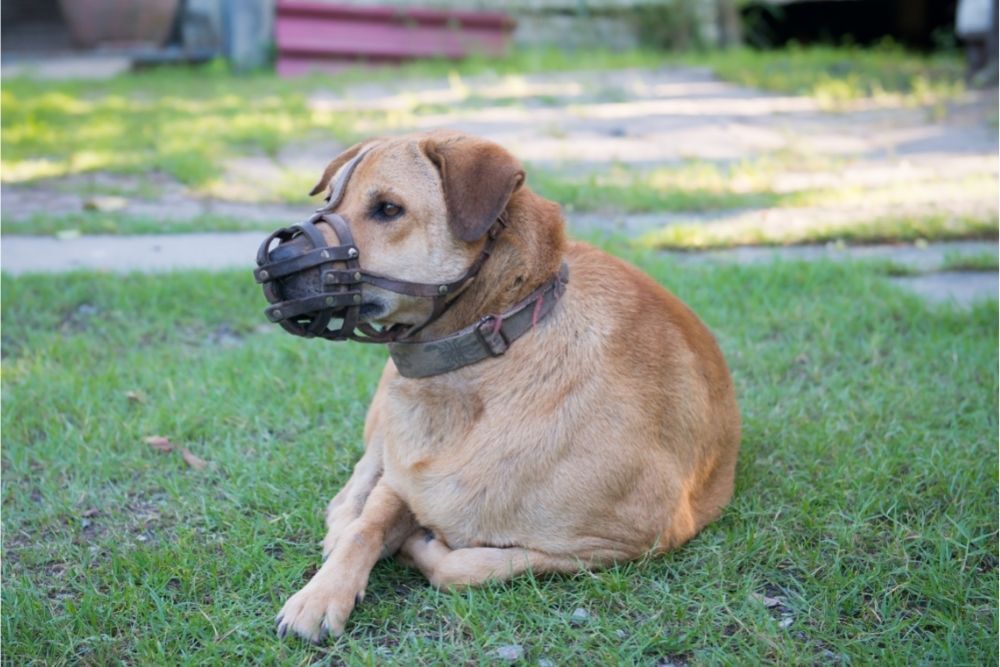One of the many common misconceptions about dogs is that when a dog is wearing a muzzle, it’s a cruel method designed to punish the dog.
Another misconception is that muzzles are a sign of an aggressive dog, which is why most other dog owners frantically pull their other dogs away from a muzzled pup.
Despite these misconceptions, muzzles can actually be a responsible safety method to protect the dog wearing the muzzle and surrounding dogs.
As long as you buy the appropriate muzzle and follow the guidelines properly, you’ll find that putting a muzzle on your dog probably has more pros than cons.

Problem is – not many people understand how long they should leave a muzzle on a dog. Surely, if you’re training your dog to be less snappy around other dogs, then you should keep the muzzle on throughout the day? Not quite.
Here is everything you need to know about how long you can leave a muzzle on a dog, including a basket muzzle!
How Long Can You Leave A Muzzle On A Dog?
Depending on the size, shape, and type of muzzle you put on your dog, the recommended length to leave a muzzle on a dog is between 15 and 45 minutes.
If you have opted to give your dog a muzzle that restricts them from drinking water, you shouldn’t leave the muzzle on for longer than 15 minutes.
This is because these muzzles are tight and uncomfortable, which can only work to further aggravate your dog. In fact, you should avoid using tight muzzles completely – more on this later.
If you have chosen a basket muzzle for your dog, or a similar muzzle design that provides enough room for your dog to comfortably drink and move their jaw, then you can leave the muzzle on for around 30-45 minutes.
After this time, your dog might begin to feel restricted and can cause claustrophobia and anxiety, rendering the muzzle somewhat useless.
Types Of Muzzles
There are an abundance of muzzles available for dogs for various reasons, and each comes with their own time limits. Here are the main muzzles to know about.
Basket Muzzles
Undoubtedly one of the most popular muzzle types is the basket muzzle. These muzzles are made of plastic (or often metal) and encases the dog’s mouth like a basket, hence the name, without touching their mouths.
This muzzle type is tied behind the ears and allows enough room for your dog to sniff other dogs, the ground, and drink water.
Some models even feature a flap at the front to give dogs better access to eating food and smelling. Basket muzzles can be left on a dog for 30-45 minutes.
Baskerville Muzzles
Baskerville muzzles are pretty much the same as basket muzzles, except the bars are more spaced out and instead of the muzzle wrapping around the ears, the muzzle features fabric straps.
This is to stop the dog from taking the muzzle off themselves. These masks are commonly used for training purposes as dogs have the best access to receiving treats from the floor.
Baskerville muzzles can be left on a dog for 30-45 minutes.
Tube Muzzles
Tube muzzles are the cheapest muzzles available.
These muzzles are made from fabric and shaped like a tube, which works to cover the dog’s mouth while keeping the nose exposed to allow for comfortable breathing.
However, these muzzles aren’t entirely safe for dogs, because it restricts them from opening their mouths to pant and drink water. Panting is essential to dogs as it helps them regulate their temperature, which is why we don’t recommend tube muzzles.
Tube muzzles can be left on a dog for 15 minutes.
Can A Dog Wear A Muzzle All Day?
While some websites will say that you can leave a muzzle on a dog all day, we highly recommend avoiding this advice.
Muzzles should only be used as a training technique or for safety reasons, for example to prevent your dog from snapping at another dog or human, which means it should only be used when applicable.
Leaving a muzzle on your dog all day will turn into punishment for the dog – not to mention the myriad of health problems that can occur.
Even though some muzzles provide enough space for a dog to move their jaws and pant, they are still restricted from comfortably eating food and drinking water.
Muzzles can cause immense pain – especially if the dog tries to remove the muzzle themselves. This goes without saying, but you should also never leave your dog alone with a muzzle.
This can contribute to irreparable damage such as separation anxiety, hyperactivity, boredom (resulting in the destruction of your home), and even aggression.
Your dog will then learn to associate the muzzle with those feelings, which will only enhance their anxiety levels.
Can I Leave A Muzzle On A Dog Overnight?
It is not safe to leave a muzzle on a dog overnight. Muzzles are designed to prevent your dog from biting others out of anxiety, trauma, stress, and aggression, making them a potentially handy training tool.
When you leave a muzzle on a dog overnight, they will associate the muzzle with punishment, which can result in an increase of anxiety and aggression.
Plus, dogs aren’t meant to lie down or sleep with a muzzle on, because the muzzle can be incredibly uncomfortable and potentially painful. This is especially true for muzzles that don’t provide enough space for the dog to pant or drink water.
It’s also worth noting that when a dog is sleeping during the night, they’re not going to be close to other animals or humans that they can bite. If there’s no reason for a dog to be anxious during the night, then what’s the point of leaving a muzzle on them?
Fortunately, there’s an abundance of other safe methods to aid your dog’s anxiety and stress.
Why Do Dogs Need Muzzles?
While most muzzles are designed to keep your dog as comfortable as possible, it’s safe to say that they will never achieve this. Still, there are several reasons why it might be wise to put a muzzle on your dog for a short period of time.
- The law – In some areas, certain breeds are required to wear a muzzle outdoors according to the law. This is because some breeds are deemed “aggressive” to other dogs and humans.
- Going to the vets – For anxious dogs or dogs with past trauma, going to the vets can be a stressful experience. Sometimes it’s easier and far safer for your dog and the vet to put a muzzle on your dog for the appointment.
- Grooming – Some dogs can find grooming a stressful experience, particularly if they have sensitive skin or have been through traumatic situations in the past. Putting a muzzle on your dog works to protect the groomer, and might work to reassure the dog that grooming isn’t a punishment.
- Aggressive dog – If you have a dog with aggressive behavioral issues, such as from poor socialization skills or past trauma, a muzzle can work to protect your dog and others. A muzzle can save your dog from being put down if they were to bite a human or a child, too.
- 8 Signs That Your Dog Is In Heat - November 8, 2022
- Why Is My Dog Whining Whilst Carrying A Toy In Their Mouth? - August 17, 2022
- Reasons Why Your Dog’s Poop Is White And What To Do About It - August 17, 2022









